Table of Contents
In microbiology, the phyllosphere is the complete above-ground plant surface seen as a microorganism habitat. Other subdivisions of the phyllosphere include the caulosphere (stems), phylloplane (leaves), anthosphere (flowers), and carposphere (roots) (fruits). The rhizosphere and laimosphere are the below-ground microbial habitats (i.e., the thin volume of soil surrounding root or subterranean stem surfaces). The majority of plants contain different microorganism communities, including bacteria, fungus, archaea, and protists. Some are useful to the plant, while others are plant diseases that can harm or kill the host plant.
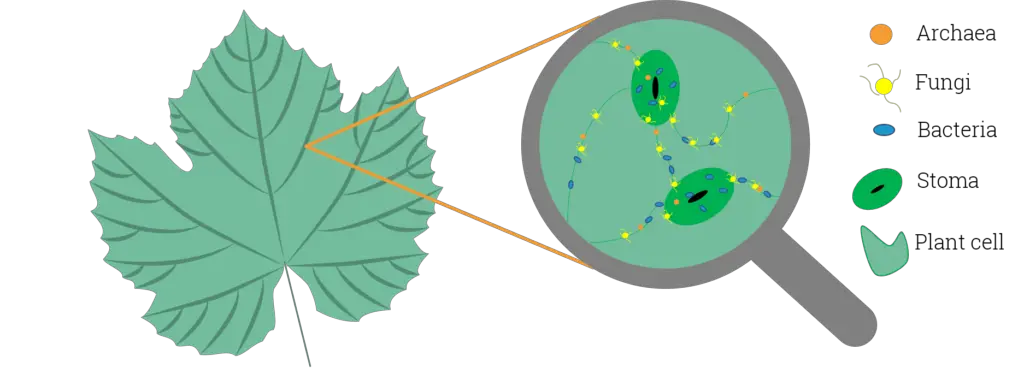
What is Phyllosphere?
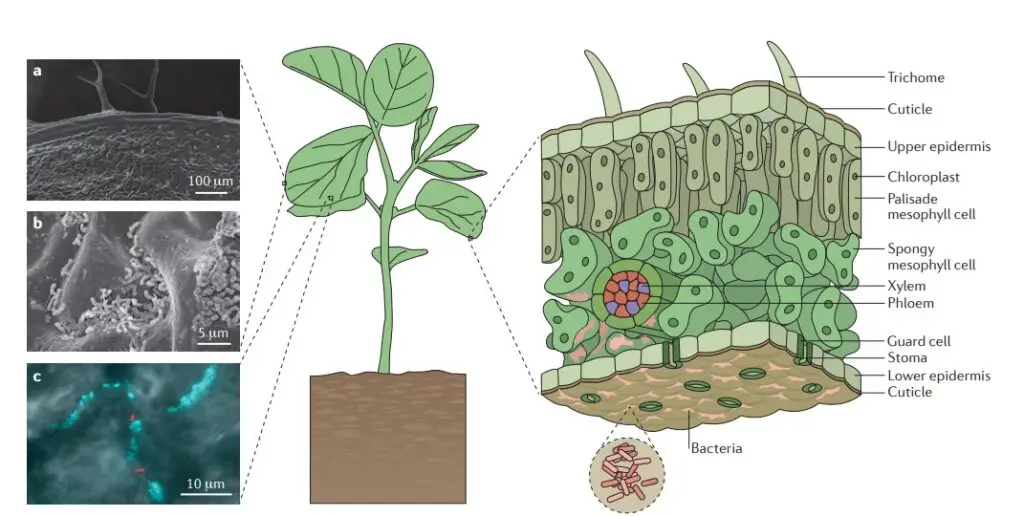
- Plants’ above-ground elements, such as their leaves, stems, and flowers, create an ecological niche known as the phyllosphere. Microorganisms, such as bacteria, fungus, viruses, and even small animals, like mites and insects, coexist in this intricate environment.
- The phyllosphere has a crucial role in plant health, nutrient cycling, and global biogeochemical cycles, making it an essential part of terrestrial ecosystems. Plant growth, disease resistance, and stress tolerance can all be affected by the microorganisms in the phyllosphere. In addition, they can help break down organic debris, fix atmospheric nitrogen, and generate greenhouse gases.
- The ability to manage agricultural and natural ecosystems, as well as predict the effects of environmental changes on plant-microbe interactions and ecosystem functioning, depends on an understanding of the ecology of the phyllosphere.
- The term phyllosphere refers to “the aerial part of a plant or the sections of a plant above the earth, often the leaf surface, considered a microorganism habitat.” This is a location where various microorganisms (bacteria, yeasts, and fungus) typically proliferate.
- The global leaf area, which corresponds to both the upper and lower surfaces, is roughly double the land surface area. The phyllosphere is the ambient zone where microorganisms invade and typically form associations with epiphytes.
- The phyllosphere’s microbial communities are exceedingly complex and comprise numerous cultured and uncultured microorganisms. Because to its various microenvironments, it possesses a heterogeneous microbial association at the micrometer scale (habitats).
- The phyllospheric microorganisms have adapted to sensitivity environmental circumstances; especially, microbial epiphytes are extremely exposed to air temperature, light, ultraviolet radiation, reduced water, and nutrition availability.
- Several external influences influence the diversity and composition of phyllospheric microbial communities. However, the type of plant and invading microbial populations (pathogens) also influence the connection between commensals and/or mutualists and their host plant.
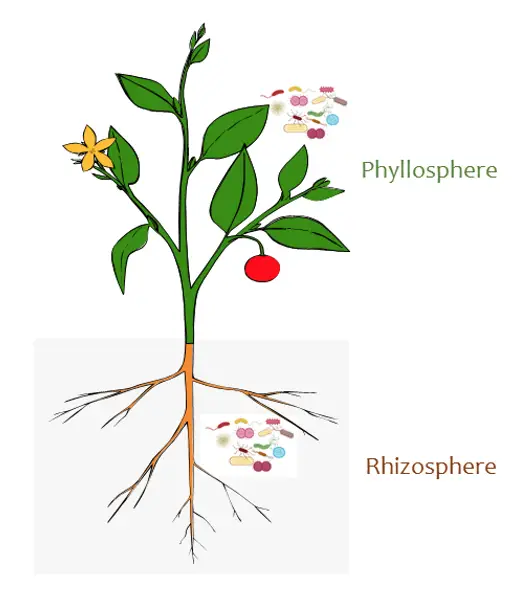
What is Phyllosphere Microorganisms?
- Phyllosphere microorganisms are the diverse communities of microorganisms that inhabit the above-ground parts of plants, including leaves, stems, and flowers. These microorganisms include bacteria, fungi, viruses, and even small animals such as mites and insects.
- The phyllosphere microorganisms are important for the health and growth of plants, as they can contribute to nutrient cycling, disease resistance, and tolerance to environmental stress. Some microorganisms in the phyllosphere can produce plant growth-promoting substances or induce systemic resistance against pathogens.
- The composition of phyllosphere microorganisms varies depending on factors such as plant species, geographical location, and environmental conditions. For example, the phyllosphere of tropical plants may have a different microbial composition than that of temperate plants. Additionally, human activities such as agriculture or pollution can alter the composition and function of phyllosphere microorganisms.
- Studying phyllosphere microorganisms can help us understand the role of microbial communities in plant-microbe interactions, ecosystem functioning, and biogeochemical cycles. It can also inform the development of strategies for managing agricultural and natural ecosystems, as well as for mitigating the impacts of environmental changes on plant health and productivity.
Leaf Structure
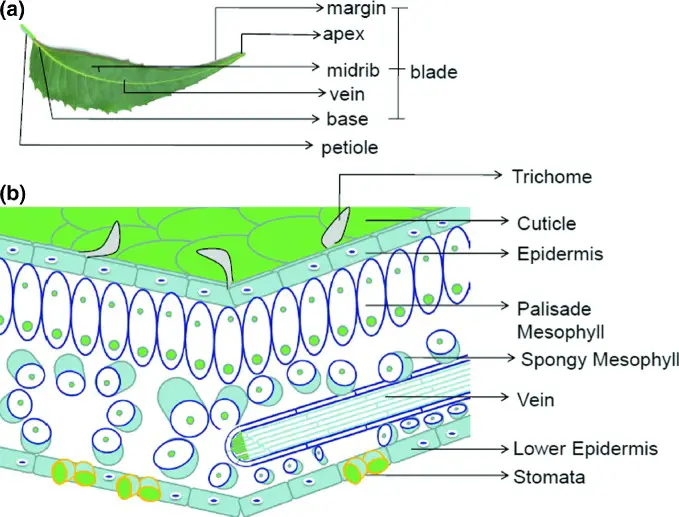
- The leaf is a highly organized and multilayered plant organ, consisting of upper and lower epidermis coated by a waxy cuticle that offers a physical barrier against abiotic and biotic stressors. The epidermis is involved in numerous leaf physiology regulatory activities, including gas exchange, temperature regulation, primary production, secondary metabolite secretion, and water mobilization.
- In addition, the epidermis contains specialized epidermal cells such as stomata, hydathodes (modified stomata), and trichomes (outgrowth). The stomata are bordered by two guard cells that can open or close in response to internal water pressure.
- Within the leaf is a layer of cells known as mesophyll, which typically consists of two layers, the palisade layer and the spongy layer.
- These cells contain chlorophyll and undergo photosynthesis. Between the palisade layer and the lower epidermis, the palisade cells are more columnar and the spongy cells are more loosely packed, allowing for gas exchange.
- The veins of the leaf contain the vascular tissue, which consists of xylem and phloem. Veins extend from the tips of the roots to the margins of the leaves. Bundle sheath cells are the outer layer cells that encircle the xylem and phloem. The xylem delivers water and the phloem sugar (food).
- Its role is connected with plant–microbe and plant–insect interactions.
- Glandular trichome of the epidermis secretes a broad variety of leaf exudates, including polysaccharide salts, lipids, volatile chemicals, and proteins.
- Nevertheless, nonglandular trichome regulates water tension, absorbs light, protects the leaf from UV radiation and heat, and enhances drought resistance.
Phyllosphere Habitat
- In the ecology, the phyllosphere is a unique and dynamic habitat that is home to an irregular and occasionally relatively extensive microbial community. The overall area of the terrestrial phyllosphere is approximately 6.4 × 108 km2 and it contains various microhabitats that serve as a significant source of microorganisms.
- The phyllosphere is naturally populated by a variety of bacteria, filamentous fungus, and yeasts, and, less frequently, protozoa and nematodes.
- In their host plants, these microorganisms demonstrate a commensalism and/or mutualism (symbionts) or antagonistic relationship.
- The connection of microorganisms in the phyllosphere has various advantages and significance for global processes, including carbon and nitrogen biogeochemical cycles and environmental effect.
Microbial Assembly on Leaf
- The arrangement of leaf epidermal cells describes the leaf’s physiology and microenvironment, allowing for the quantity and dispersion of microorganisms on the leaf surface. Simply put, epiphytes produce biofilm-like development, with bigger bacterial aggregation preferentially occurring on the trichomes, veins, and epidermal cell groves, where the leaf exudates contain nutrient-rich regions.
- The outer cuticle and its physiology aid in the colonization of this location by microorganisms. The presence of aliphatic compounds in the cuticle layer controls the physicochemical qualities of the leaf surface and confers permeability and wettability, hence facilitating the adhesion of microbes.
- This site’s water permeability may be crucial to the survival and growth of epiphytes. In addition, nutrient and water leaching enables epiphytes to consume and form colonies on the phyllosphere.
- Bacterial communities are densely populated on leaf surfaces with more water and nutrient penetration. In general, bacteria maintain cuticular permeability through the secretion of biosurfactants; for instance, Pseudomonas syringae secrete syringafactin on the cuticle layer of the leaf, which increases the availability of sugar for prolonged epiphytic development.
- Similarly, fructose accessibility in Pantoea eucalypti 299R and Pantoea agglomerans was determined. Figure depicts the phyllosphere microbial community, in which the epiphytic microorganism leverages this milieu for specialized microbe dispersal, survival, and flowering (colonization).
- Simultaneously, surface microorganisms alter the phyllosphere’s chemistry, so rendering heterotrophic oligotrophic epiphytic life. In addition, microorganisms form unique niches on the leaf surface due to their interacting style of life; in these microhabitats, the microbial population can be sustained continuously.
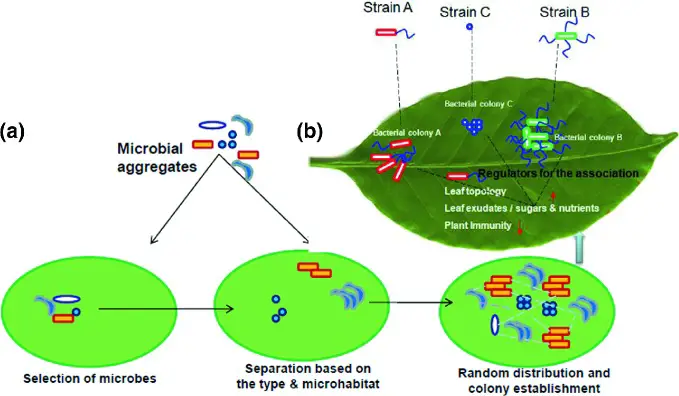
Microorganisms found in Phyllosphere (Phyllosphere microbiome)
- The phyllosphere microbiome refers to the diverse community of microorganisms that inhabit the above-ground parts of plants, including leaves, stems, and flowers. These microorganisms can include bacteria, fungi, viruses, and even small animals such as mites and insects.
- Bacteria are the most common microorganisms found in the phyllosphere, with thousands of species identified across various plant species and environments. Some common genera include Pantoea, Pseudomonas, and Sphingomonas. Fungi are also present, including both plant pathogens and beneficial symbionts such as mycorrhizae. Examples of fungal genera found in the phyllosphere include Aspergillus, Penicillium, and Cladosporium.
- Viruses have also been found in the phyllosphere, although they are less well-studied than bacteria and fungi. Some phyllosphere viruses have been shown to be plant pathogens, while others may play a role in regulating microbial communities or interacting with the host plant.
- In addition to microorganisms commonly found in the phyllosphere, other groups such as archaea and protists have also been identified. The composition of phyllosphere microbiomes can vary depending on various factors such as plant species, geographical location, and environmental conditions.
- Understanding the diversity and function of phyllosphere microbiomes is important for managing plant health and productivity, as well as for predicting the impacts of environmental changes on plant-microbe interactions and ecosystem functioning. It can also inform the development of strategies for promoting beneficial microorganisms and suppressing harmful ones in agricultural and natural ecosystems.
1. Bacterial Diversity in the Phyllosphere
- The phyllosphere, a complex and diverse environment, is home to an unfathomable number of bacterial inhabitants. The average density of bacteria in this microscopic jungle ranges from a staggering 106 to 108 cells per square centimeter.
- However, the population of these epiphytic bacteria is hardly homogeneous, as it is subject to a litany of environmental and physical factors that give rise to bewildering levels of variation.
- The phyllosphere’s conditions, in particular, dictate the type and number of bacteria present on any given leaf surface, with broad-leaf plants typically hosting more bacterial inhabitants than grasses or waxy broad-leaf plants.
- The phyllosphere is a hub of microbial diversity, housing a range of bacteria from four primary phyla, namely Proteobacteria, Firmicutes, Bacteroides, and Actinobacteria. Among these, methylotrophic bacteria, which include Methylobacterium, Methylophilus, Methylibium, Hyphomicrobium, Methylocella, Methylocapsa, and Methylocystis, are particularly abundant.
- Studies have shown that specific assemblage regulations dictate the organization of bacterial communities in the phyllosphere, with factors such as soil type, plant genotype and species, plant immune system, age, climatic conditions, and geographic region influencing bacterial community assembly.
- Extensive research has been conducted on bacterial colonization in Arabidopsis thaliana and maize, with Proteobacteria, Actinobacteria, and Bacteroidetes being the most abundant phyla colonizing the leaf and root of A. thaliana.
- Additionally, studies have identified prevalent bacterial genera in A. thaliana, including Massilia, Flavobacterium, Pseudomonas, and Rathayibacter, Deinococcus thermus on tree phyllosphere, and Bacillus and Pantoea dominating lettuce.
2. Fungal Microbiota of Phyllosphere
- The fungal microbiota of the phyllosphere plays an important role in the health and growth of plants. Fungi can be beneficial or harmful to the plant depending on the species and the environmental conditions. Beneficial fungi can help protect the plant from harmful pathogens, while harmful fungi can cause disease and reduce plant growth and productivity.
- Fungi may vary from plant to plant and approximately 5 × 104 cells cm−2.
- Studies have shown that the fungal microbiota of the phyllosphere is highly diverse and can vary depending on factors such as plant species, geography, and season. The most common fungal groups found in the phyllosphere include Ascomycota, Basidiomycota, and Zygomycota.
- Fungi in the phyllosphere can be dispersed by wind, rain, or insects, and can colonize the plant through natural openings or wounds in the cuticle. Some fungi can also produce spores that can germinate on the plant surface.
- Understanding the diversity and function of the fungal microbiota in the phyllosphere is important for developing strategies to enhance plant growth and protect against plant pathogens. This knowledge can also be useful in the development of biological control agents for plant diseases.
- Exampls: Aspergillus niger, Fusarium oxysporum, Penicillium aurantiogriseum, Fusarium incarnatum, Alternaria alternata, Alternaria tenuissima, Cladosporium cladosporioides, Talaromyces funiculosus, Aspergillus flavus, Trichoderma aureoviride, Trichoderma harzianum, Penicillium janthinellum, Fusarium proliferatum, Fusarium equiseti, and Aspergillus stellatus from wheat plant.
3. Actinomycetes Diversity in Phyllosphere
- Actinobacteria, a group of gram-positive bacteria, have piqued the interest of scientists due to their diverse adaptations to different environments, including the phyllosphere of plants. Not only are they soil-inhabiting saprophytic microbes, but they also form symbiotic associations within plant tissues.
- These associations have generated immense significance to the host and its environment through their novel metabolites. The diversity and distribution of endophytic actinobacteria have been extensively studied, ranging from medicinal plants to crop plants and other terrestrial plants.
- Reports reveal that the actinomycetes diversity in the phyllosphere is high in tropical and temperate ecosystems, further highlighting the complexity of this fascinating group of microbes.
- The physiology of the plant and the environment determines the actinobacterial association in plants and allows them to establish endophytic life, adding another layer of intricacy to their behavior.
- Moreover, various species of actinobacteria have been reported from different plants such as Triticum aestivum, Lupinus termis, Lobelia clavatum, Acacia auriculiformis, Aquilaria crassna, Oryza sativa, Xylocarpus granatum, and Elaeagnus angustifolia, among others, from various environments like arid, semiarid, and mangrove.
- These species include Actinoplane missouriensis, Actinoallomurus acacia, Actinoallomurus coprocola, Actinomadura glauciflava, Amycolatopsis tolypomycina, Actinoallomurus oryzae, Jishengella endophytica, Kribbella sp., Microbispora mesophila, Microbispora sp., Micromonospora sp., Nocardioides sp., Nocardia alba, Nonomuraea rubra, Micromonospora sp., Nonomuraea sp., Pseudonocardia sp., Planotetraspora sp., Pseudonocardia endophytica, Pseudonocardia halophobica, Streptomyces sp., and Streptomyces javensis.
- The versatility and diversity of actinobacteria in the phyllosphere highlight their potential for therapeutic secondary metabolites and their importance to the ecosystem.
Phyllosphere microbiome of Stem (caulosphere)
- The subset of the phyllosphere microbiome that specifically inhabits the stem of plants is known as the caulosphere microbiome.
- The caulosphere microbiome is important for plant health and growth, as it can contribute to nutrient cycling, disease resistance, and stress tolerance. The composition of the caulosphere microbiome can vary depending on factors such as plant species, environmental conditions, and geographic location.
- Recent research has shown that the caulosphere microbiome is a diverse and complex community, consisting of bacteria, fungi, and other microorganisms. Studies have also suggested that the caulosphere microbiome may play a role in plant-microbe interactions, as well as in the production of secondary metabolites that can benefit both the plant and the microorganisms.
- Understanding the dynamics of the caulosphere microbiome and its interactions with plants is an important area of research, with potential implications for agriculture, ecology, and human health.
- The caulosphere microbiome can include a wide variety of microorganisms, including bacteria, fungi, and other microbes. Some examples of microorganisms commonly found in the caulosphere microbiome include:
- Bacteria: Pseudomonas, Bacillus, Rhizobium, Agrobacterium, and Sphingomonas are some of the bacteria commonly found in the caulosphere microbiome. These bacteria can contribute to plant growth and health by fixing nitrogen, producing growth-promoting compounds, and suppressing pathogens.
- Fungi: Ascomycetes, Basidiomycetes, and Zygomycetes are some of the fungal groups found in the caulosphere microbiome. These fungi can form mutualistic relationships with plants, providing them with nutrients and protection from pathogens. Some fungi also produce bioactive compounds that can have pharmaceutical and agricultural applications.
- Archaea: While less well-studied than bacteria and fungi, archaea have been found in the caulosphere microbiome. They can play roles in nutrient cycling and other metabolic processes.
- Viruses: Viruses have also been found in the caulosphere microbiome, although their roles are not yet well understood. Some studies suggest that viruses may play a role in regulating microbial communities and influencing plant health.
Phyllosphere microbiome of Leaves (phylloplane)
- The phylloplane microbiome refers to the community of microorganisms that live on the surfaces of leaves. This community is diverse and includes bacteria, yeasts, filamentous fungi, algae, protozoa, and nematodes. Among these, bacteria are the most abundant inhabitants of the phylloplane, with an estimated 106-107 bacteria per square centimeter of leaf surface.
- The microenvironment of the phylloplane is determined by the arrangement of leaf epidermal cells, which creates nutrient-rich regions for microorganisms to colonize. Bacteria tend to form larger aggregates on leaf surfaces, especially at depressions formed at the junctions of epidermal cells, along the veins, and at the bases of trichomes.
- Fungal communities on leaves are hypervariable in temperate regions and even more diverse in the phyllosphere of tropical trees. Filamentous fungi are considered transient inhabitants of leaf surfaces, with spores as predominant forms, whereas rapidly sporulating species and yeasts colonize the habitat more actively.
- The physical characteristics of the leaf surface, such as the outer cuticle and its physiology, enable microorganisms to colonize the phylloplane, while leaching of nutrients along with water allows the epiphytes to utilize and develop colonies on the leaf surface.
- The type of plant species also influences the types of microorganisms inhabiting the phylloplane region. Studies have shown that the microbial communities of leaves are diverse and consist of many different genera of microorganisms.
- Overall, the phylloplane microbiome plays an important role in plant health and growth, as it can contribute to nutrient cycling, disease resistance, and stress tolerance. Understanding the dynamics of the phylloplane microbiome and its interactions with plants is an important area of research, with potential implications for agriculture, ecology, and human health.
Phyllosphere microbiome of Flowers (anthosphere)
- The anthosphere, which refers to the region around flowers, is an important habitat for microbial growth. This region is colonized by a diverse range of microorganisms that are specific to each flower. However, some genera of bacteria and fungi are consistently found across many different agricultural and ornamental plants. The fungal population is the highest in the anthosphere, followed by bacteria.
- The various components of flowers, such as pollen, nectar, sepals, petals, stamens, style, ovary, and stigmas, provide microsites for the colonization of microorganisms.
- Basidiomycetous yeasts are abundant on the surface of floral organs, while nectar and pollen host mostly ascomycetous yeast species. Pollen, in particular, has a high bacterial count, ranging between 106 and 109, and the diversity and composition of the bacterial community varies from species to species due to differences in nutrient composition, pollen viability, pollen structure, and moisture.
- The epiphytic bacteria in the anthosphere exist either as single cells or in clusters, often forming thin biofilms in certain habitats.
- Some medicinal flowers in the temperate region have been found to host endophytic fungi, such as Pestalotiopsis disseminate, Phomopsis, and Coelomycete sp., which produce therapeutic metabolites. The anthosphere is a dynamic habitat that supports a complex and diverse microbial community that plays an important role in flower and plant health.
Phyllosphere microbiome of Fruits (carposphere)
- The carposphere is a unique and constantly changing environment that is subjected to irregular changes in temperature, UV radiation, relative humidity, and nutrient availability on the surface of the plant. Fruits are an important habitat in the phyllosphere as they are rich in sugar and provide a common source of food for many yeast species.
- The skin of fruits harbors diverse groups of microbes, including both bacteria and fungi. While the entry of microorganisms inside the fruit is relatively infrequent due to the presence of a tough, waterproof covering, the type of microorganisms present on the fruit depends on its chemical composition.
- For example, it has been observed that fruits like lemons and oranges harbor a large number of yeasts, while grapes and apples have a higher number of bacterial cells.
- The microbial community in the carposphere is transient because fruits have a shorter lifespan than other parts of the phyllosphere.
- The microbial communities in fruits may also differ throughout their development, as the microorganisms present in the buds of fruits might not be present in the fully developed fruit.
Mechanism of Microbial Interaction with the Phyllosphere
- The complex interplay between leaf physiology and microbial diversity and abundance on the phyllosphere has been the subject of much research. It is believed that the microorganisms that inhabit this unique habitat must adapt to the physiology of the leaf in order to survive.
- Interestingly, epiphytic microbes have been observed to form colonial associations that provide them with protection from the harsh conditions of the phyllosphere.
- These colonial associations are particularly common among bacteria, which tend to develop larger-sized associations on the surface of the leaf, especially at the veins and grooves of epidermal cells.
- These grooves are rich in nutrients, such as sugar and water, and are typically less covered in waxy cuticle than other regions of the leaf surface. This cuticle acts as a barrier to prevent the permeability and wettability of the leaf surface, regulating the colonization of microbes on the phyllosphere.
- The droplets of water present on the surface of leaves are actually helping the compounds to diffuse from one place to another. This happens because the droplets diffuse the waxy cuticle and make it more permeable.
- The diffusion of compounds from the apoplast to the phyllosphere surface is greatly improved by this process. The water and compounds that are present on the phyllosphere are also providing the necessary nutrients to microorganisms.
- One of the most common ways in which the permeability of the guard cells and their surface cuticles is increased is through transpiration. This allows the microbes to colonize the surface more densely. Some surface bacteria are even able to produce certain compounds, such as biosurfactants, which can modify the cuticle surfaces of the leaf and establish an association.
- This can facilitate the availability of water and alter sugar availability, thereby improving living conditions for epiphytic bacterial growth.
- Certain epiphytes like Pseudomonas sp., Stenotrophomonas sp., and Achromobacter increase the water permeability of the lipophilic cuticle present in Hedera and Prunus. This, in turn, increases the availability of compounds at the phyllosphere and improves epiphytic fitness on the leaf surface.
- Studies have shown that the presence of fructose in the phyllosphere of beans can promote the growth of Erwinia herbicola and Pantoea agglomerans. However, the irregular distribution of fructose can also differentially promote the population of P. eucalypti on bean leaves. This suggests that the carbon sources on the leaf surface are utilized by the epiphytic microorganisms for their growth and multiplication. The phyllosphere microbial population can also influence the physicochemical properties of the leaf with the help of both biotic and abiotic surroundings.
- The soil microbial community can also influence the determination of phyllosphere microbial diversity. However, the microbes can construct niches in the phyllosphere microhabitat wherein they can sustain and establish their population steadily.
- Recent studies have revealed special relationships between bacterial species in the phyllosphere community. The presence of sugars and nutrients in this environment significantly changes individual bacterial cells within the microbial aggregates.
- These aggregates would spatially be established with cell-to-cell interactions along with direct physical interactions. The community structure is organized based on driven factors such as dispersal, selection of microbes, diversification, and ecological drift. The fitness of the community is due to internal (strain types) and external determinants (environment) of the phyllosphere.
- Bacteria have the ability to communicate with each other and form communities that consist of different populations with mutualistic and cooperative partnerships. However, there are cases where a mutualistic relationship between rapidly growing bacteria and pathogenic fungi can lead to a superficial infection on the host plant, which allows the bacteria to access more nutrients and increase their population size.
- On the other hand, fungal-fungal interactions can reduce the bacterial population, such as when oomycete species Dioszegia sp. and Albugo sp. outcompete the bacterial microbiota on A. thaliana leaf.
- Competitive interactions between microbes often involve negative effects on at least one species in the habitat. Some competitive microbes produce toxic chemical substances such as antibiotics and siderophores as secondary metabolites that have a negative effect on their competitor microbes.
- For example, the gram-negative bacterium Pantoea agglomerans inhibits the growth of Erwinia amylovora, a phytopathogen of apple, through its antibiotic activity.
Interactions in the phyllosphere
There are three main types of interactions that occur in the phyllosphere: plant-microorganism, microorganism-microorganism, and microorganism-herbivore-plant interactions.
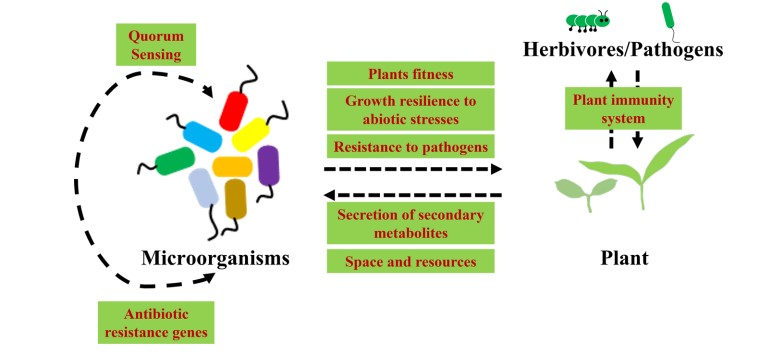
- Plant-microorganism interactions: These interactions occur between the plants and the microorganisms that live on their surfaces. Many microorganisms, such as bacteria and fungi, form mutualistic relationships with plants, providing them with essential nutrients or promoting their growth. Other microorganisms, such as pathogens, can cause disease or reduce plant growth.
- Microorganism-microorganism interactions: These interactions occur between different microorganisms that inhabit the phyllosphere. Some microorganisms compete with each other for nutrients or space, while others form synergistic relationships that can benefit both microorganisms.
- Microorganism-herbivore-plant interactions: These interactions occur between the microorganisms, herbivores, and plants in the phyllosphere. Some microorganisms can produce compounds that repel or attract herbivores, while others can provide nutrients to the plants that can make them more resistant to herbivores. Some herbivores can also alter the composition of the phyllosphere microorganisms by feeding on certain types of microorganisms, which can have both positive and negative effects on plant health.
Sources of Phyllosphere Microorganisms

The phyllosphere is the above-ground portion of plants, including leaves, stems, and flowers, where microorganisms such as bacteria and fungi can reside. There are several sources of phyllosphere microorganisms, including:
- Airborne microorganisms: Microorganisms can be transported by air currents and deposited on plant surfaces. They can come from natural sources such as soil, water bodies, and plants themselves, as well as human-made sources such as agricultural practices and industrial activities.
- Soil microorganisms: Some microorganisms in the phyllosphere originate from soil, where they can be transported to plant surfaces through rainwater or wind.
- Seed-borne microorganisms: Some microorganisms can be present on the surface of seeds and can be transferred to the phyllosphere during germination and plant growth.
- Insect and animal vectors: Insects and other animals can carry microorganisms on their bodies and transfer them to plant surfaces while feeding or interacting with plants.
- Human activity: Human activities such as farming, gardening, and landscaping can introduce microorganisms to the phyllosphere through the use of soil amendments, fertilizers, pesticides, and other chemicals.
Plant responses to phyllosphere microorganisms
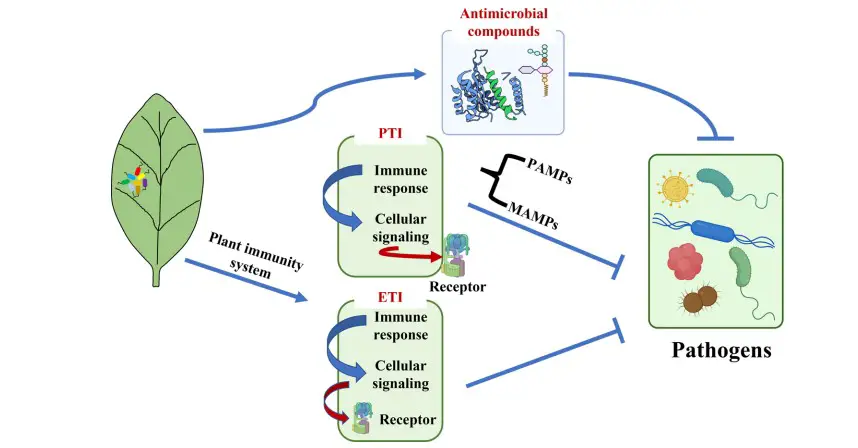
- Plants have a complex immune system that enables them to recognize and respond to different microorganisms that inhabit the phyllosphere. This immune system includes pattern-triggered immunity (PTI) and effector-triggered immunity (ETI), which are two different branches of the plant immune response.
- PTI is the first line of defense against phyllosphere microorganisms and is triggered by the recognition of microorganism-associated molecular patterns (MAMPs), pathogen-associated molecular patterns (PAMPs), and damage-associated molecular patterns (DAMPs) by the plant’s pattern recognition receptors (PRRs). When a PRR recognizes a MAMP or PAMP, it triggers a cascade of downstream signaling events that activate various defense responses, including the production of reactive oxygen species (ROS), the expression of defense-related genes, and the reinforcement of the plant cell wall. DAMPs are released by damaged plant cells and can also trigger PTI responses.
- ETI is a more specific and powerful response that is triggered when a plant recognizes the presence of specific effectors produced by a pathogenic microorganism. Effectors are proteins that are secreted by microorganisms to manipulate the plant’s cellular processes and promote infection. When a plant recognizes an effector, it triggers a highly specific response that often involves the programmed cell death of the infected cells, which prevents the spread of the infection.
- Overall, the plant immune system is a highly sophisticated and dynamic system that allows plants to recognize and respond to the presence of phyllosphere microorganisms, including both beneficial and pathogenic microorganisms. By understanding how plants respond to these microorganisms, we can develop strategies to enhance plant health and productivity while minimizing the negative impacts of pathogens.
Ecological roles of phyllosphere microorganisms
Phyllosphere microorganisms play important ecological roles in the environment, influencing plant health and growth, nutrient cycling, and interactions with other organisms. Here are some of the main ecological functions of phyllosphere microorganisms:
- Nutrient cycling: Phyllosphere microorganisms contribute to the cycling of nutrients by breaking down organic matter and recycling nutrients back into the ecosystem. Some microorganisms can also fix atmospheric nitrogen and make it available to plants.
- Plant growth promotion: Many phyllosphere microorganisms can promote plant growth by producing growth-promoting hormones, enhancing nutrient uptake, and protecting plants from pathogens and other stresses.
- Pathogen control: Some phyllosphere microorganisms can control plant pathogens by producing antibiotics or competing for resources with pathogens. These microorganisms can help to reduce the incidence and severity of plant diseases.
- Carbon sequestration: Phyllosphere microorganisms can contribute to carbon sequestration by fixing carbon dioxide into organic compounds and promoting plant growth.
- Interactions with other organisms: Phyllosphere microorganisms can interact with other organisms in the ecosystem, including herbivores and predators. Some microorganisms can produce compounds that deter herbivores or attract predators, while others can be consumed by herbivores and other organisms.
Factors influencing the growth and activities of Phyllosphere Microorganisms
Phyllosphere microorganisms are influenced by various factors that affect their growth and activities. Some of the key factors include:
- Plant species: Different plant species support different communities of phyllosphere microorganisms. This is partly due to the differences in the chemical composition of plant surfaces, which can affect the growth and survival of microorganisms.
- Plant age: The age of the plant can also influence the composition and abundance of phyllosphere microorganisms. Younger plants tend to have fewer microorganisms than older plants, which have had more time to accumulate microbial communities.
- Climate and weather: Environmental factors such as temperature, humidity, and rainfall can affect the growth and activities of phyllosphere microorganisms. For example, high humidity can promote fungal growth, while dry conditions can inhibit microbial activity.
- Nutrient availability: The availability of nutrients such as nitrogen and phosphorus can influence the growth and activities of phyllosphere microorganisms. Plants can release nutrients onto their surfaces, which can support the growth of microbial communities.
- Interactions with other microorganisms: Phyllosphere microorganisms can interact with each other, either positively or negatively, which can affect their growth and activities. For example, some microorganisms can produce compounds that inhibit the growth of other microorganisms.
Positive effect of Phyllosphere microorganisms on Plants
- Promoting growth: Some phyllosphere microorganisms produce plant growth-promoting hormones such as auxins, cytokinins, and gibberellins, which can stimulate plant growth and development.
- Nutrient acquisition: Phyllosphere microorganisms can help plants acquire nutrients such as nitrogen, phosphorus, and potassium by fixing atmospheric nitrogen or breaking down organic matter.
- Disease resistance: Some phyllosphere microorganisms can protect plants from disease by producing antibiotics or other compounds that inhibit the growth of plant pathogens.
- Stress tolerance: Phyllosphere microorganisms can help plants tolerate environmental stresses such as drought, heat, and cold by producing compounds that protect against oxidative stress or by stimulating the plant’s own stress response mechanisms.
- Improved photosynthesis: Some phyllosphere microorganisms can enhance photosynthesis in plants by increasing the efficiency of light absorption or by reducing photorespiration.
- Biocontrol agents: Phyllosphere microorganisms can act as biocontrol agents, protecting plants from insect pests by producing toxins or repelling the pests through volatile organic compounds.
- Bioremediation: Some phyllosphere microorganisms have the ability to degrade pollutants in the environment, making them useful for bioremediation of contaminated soils or water.
- Improved water use efficiency: Phyllosphere microorganisms can help plants use water more efficiently by improving the plant’s ability to retain water or by reducing water loss through transpiration.
- Improved nutrient uptake: In addition to helping plants acquire nutrients, some phyllosphere microorganisms can improve nutrient uptake by increasing the surface area of the plant root system or by secreting enzymes that break down complex nutrients into forms that are easier for plants to absorb.
- Improved seed germination: Phyllosphere microorganisms can improve seed germination by breaking down seed coatings or by producing compounds that stimulate seed growth.
Negative effect of Phyllosphere microorganisms on Plants
While phyllosphere microorganisms can have many positive effects on plants, they can also have negative effects. Some examples include:
- Disease-causing microorganisms: Just as some phyllosphere microorganisms can protect plants from disease, others can cause diseases such as leaf spots, blights, or wilts.
- Nutrient depletion: Some phyllosphere microorganisms can compete with plants for nutrients, which can lead to nutrient depletion in the soil and reduced plant growth.
- Indirect herbivory: Some phyllosphere microorganisms can attract herbivorous insects to plants, which can damage the plant and reduce its productivity.
- Allelopathy: Some phyllosphere microorganisms can produce allelopathic compounds that inhibit the growth of other plants, leading to reduced plant diversity.
- Reduced photosynthesis: While some phyllosphere microorganisms can improve photosynthesis in plants, others can reduce photosynthesis by blocking stomata or reducing the efficiency of the photosynthetic process.
Differences in soil bacteria and phyllosphere bacteria
Soil bacteria and phyllosphere bacteria are two types of bacteria that play important roles in ecological processes, but they differ in several ways:
- Habitat: Soil bacteria live in the soil environment, while phyllosphere bacteria live on the surface of plants, especially on leaves.
- Diversity: Soil bacteria are generally more diverse than phyllosphere bacteria, as soil is a complex and varied environment that supports many different bacterial species.
- Nutrient availability: Soil bacteria have access to a wide range of nutrients in the soil, while phyllosphere bacteria are limited by the nutrients available on the surface of leaves.
- Physiological adaptation: Phyllosphere bacteria have developed physiological adaptations to survive on the surface of leaves, including the ability to tolerate desiccation and exposure to UV radiation.
- Role in plant health: Phyllosphere bacteria play a critical role in plant health, as they can help to protect plants from pathogenic bacteria and fungi and promote plant growth. Soil bacteria also play an important role in plant health, but their effects are less direct, as they are involved in nutrient cycling and soil structure.
- Interactions with other organisms: Soil bacteria interact with a wide range of organisms, including plants, fungi, and animals, while phyllosphere bacteria primarily interact with the plant host and other phyllosphere bacteria.
In summary, soil bacteria and phyllosphere bacteria differ in their habitat, diversity, nutrient availability, physiological adaptation, role in plant health, and interactions with other organisms. Understanding these differences is important for understanding the ecological processes that occur in soil and on plant surfaces.
FAQ
What are phyllosphere microorganisms?
Phyllosphere microorganisms are the microbial communities that live on the surfaces of plant organs, such as leaves, flowers, fruits, and stems.
What types of microorganisms are found in the phyllosphere?
The phyllosphere contains a diverse range of microorganisms, including bacteria, fungi, yeasts, algae, protozoa, and nematodes.
How do microorganisms colonize the phyllosphere?
Microorganisms can colonize the phyllosphere by using a variety of mechanisms, including wind dispersal, water droplets, and insect vectors.
What factors influence the composition of phyllosphere microbial communities?
The composition of phyllosphere microbial communities is influenced by a variety of factors, such as host plant species, environmental conditions, and the presence of other microorganisms.
What is the function of phyllosphere microorganisms?
Phyllosphere microorganisms can have a variety of functions, including nutrient cycling, pathogen suppression, and plant growth promotion.
What are some common methods used to study phyllosphere microorganisms?
Common methods used to study phyllosphere microorganisms include microbial culturing, molecular techniques such as PCR and sequencing, and microscopy.
How do phyllosphere microorganisms affect plant health?
Phyllosphere microorganisms can have both positive and negative effects on plant health. Some microorganisms can promote plant growth and protect against pathogens, while others can cause disease or inhibit growth.
Can phyllosphere microorganisms be used as biocontrol agents?
Yes, some phyllosphere microorganisms have been found to have biocontrol potential and can be used as natural alternatives to chemical pesticides.
How does the composition of phyllosphere microbial communities vary across different plant species?
The composition of phyllosphere microbial communities can vary greatly across different plant species, as each plant species has unique characteristics that can influence the types and abundance of microorganisms present.
How might climate change impact phyllosphere microbial communities?
Climate change could potentially alter phyllosphere microbial communities by changing environmental conditions, such as temperature and precipitation, which could affect the abundance and composition of microorganisms present.
References
- Sivakumar N, Sathishkumar R, Selvakumar G, Shyamkumar R, Arjunekumar K. Phyllospheric Microbiomes: Diversity, Ecological Significance, and Biotechnological Applications. Plant Microbiomes for Sustainable Agriculture. 2020 Mar 7;25:113–72. doi: 10.1007/978-3-030-38453-1_5. PMCID: PMC7123684.
- Lindow SE, Brandl MT. Microbiology of the phyllosphere. Appl Environ Microbiol. 2003 Apr;69(4):1875-83. doi: 10.1128/AEM.69.4.1875-1883.2003. PMID: 12676659; PMCID: PMC154815.
- Vorholt, J. Microbial life in the phyllosphere. Nat Rev Microbiol 10, 828–840 (2012). https://doi.org/10.1038/nrmicro2910
- Vorholt, J. A. (2012). Microbial life in the phyllosphere. Nature Reviews Microbiology, 10(12), 828–840. doi:10.1038/nrmicro2910
- Lindow, S. E., & Brandl, M. T. (2003). Microbiology of the Phyllosphere. Applied and Environmental Microbiology, 69(4), 1875–1883. doi:10.1128/aem.69.4.1875-1883.2003
- Stone, B. W. G., Weingarten, E. A., & Jackson, C. R. (2018). The Role of the Phyllosphere Microbiome in Plant Health and Function. Annual Plant Reviews Online, 533–556. doi:10.1002/9781119312994.apr0614
- http://eagri.org/eagri50/AMBE101/pdf/lec19.pdf
- https://www.slideshare.net/nagatrinath59/phyllosphere
- https://www.research-collection.ethz.ch/bitstream/handle/20.500.11850/59727/Microbial_life_in_phyllosphere.pdf;jsessionid=FC993AB05AEF36515A44F76A1BDAE364?sequence=2
- https://www.sciencedirect.com/topics/agricultural-and-biological-sciences/phyllosphere
- https://www.onlinebiologynotes.com/microbiology-of-phyllosphere/
